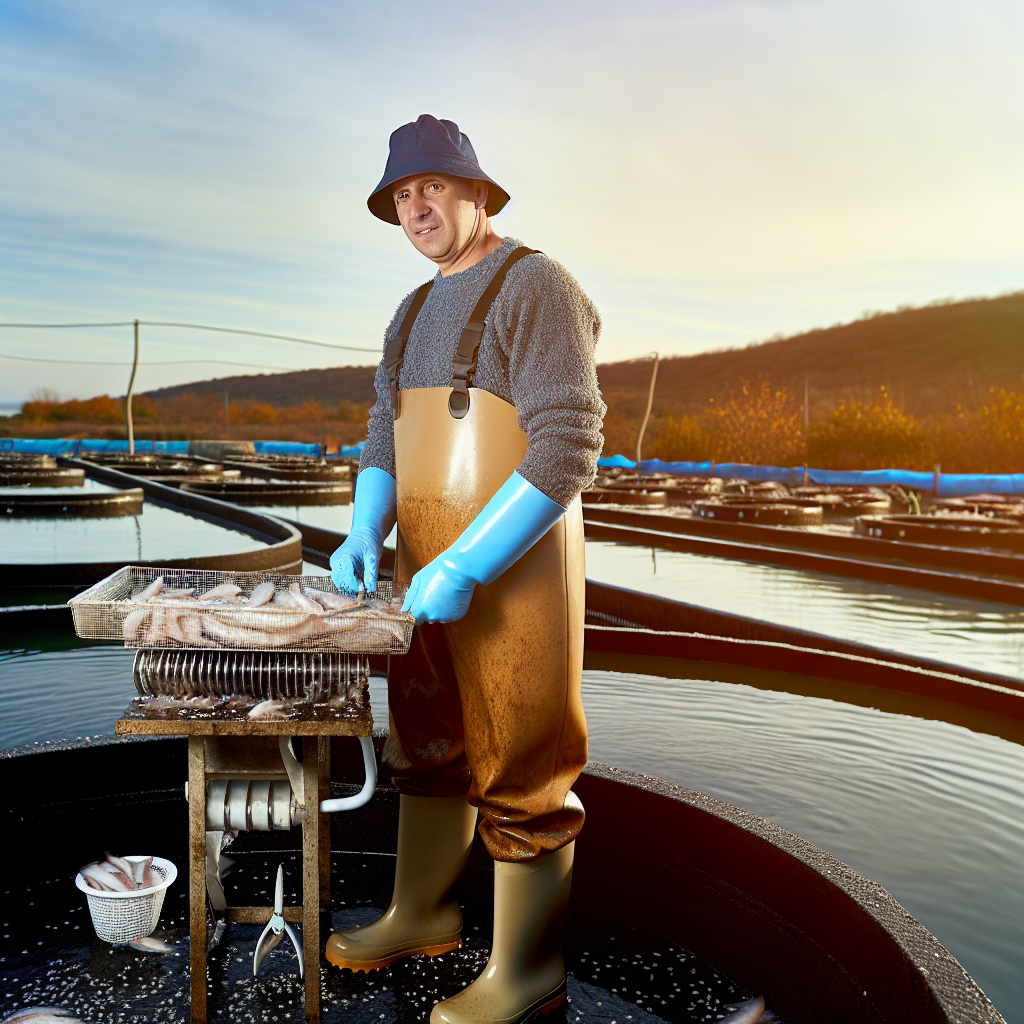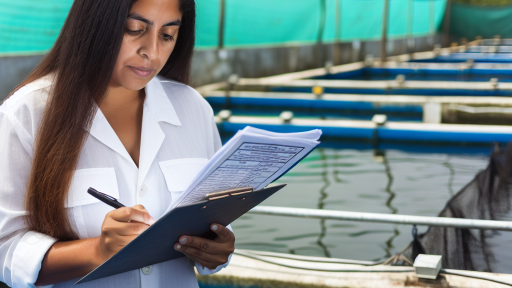Understanding the Basics of Fish Farming
Key Concepts of Fish Farming
Fish farming, also known as aquaculture, raises fish for consumption.
This sustainable practice offers numerous benefits.
First, it helps meet the increasing global demand for seafood.
Second, it contributes to food security in various regions.
Fish farming can utilize different systems.
These include pond systems, tank systems, and cage systems.
Each system has its unique advantages and challenges.
Essential Practices in Fish Farming
Healthy stock management is vital in fish farming.
This includes selecting appropriate fish species.
Moreover, maintaining optimal water quality supports fish health.
Regular monitoring can prevent disease outbreaks.
Feeding practices also play a crucial role.
Using balanced diets promotes growth and sustainability.
Additionally, understanding fish behavior aids in effective farming.
Choosing the Right Fish Species
Selecting the right fish species is foundational to success.
Transform Your Agribusiness
Unlock your farm's potential with expert advice tailored to your needs. Get actionable steps that drive real results.
Get StartedPopular farmed fish include tilapia, catfish, and trout.
Each species has different habitat and care requirements.
While tilapia is hardy, trout need cooler water.
Research on local market demand helps inform this choice.
Water Quality Management
Water quality impacts fish growth and overall farm health.
You should regularly test pH, ammonia, and oxygen levels.
Maintaining clean water reduces stress and diseases among fish.
Implementing filtration systems can significantly enhance water quality.
Utilizing water recirculation systems is also an efficient strategy.
Feeding Techniques and Nutrition
Providing the right nutrition maximizes fish growth rates.
Commercial feed often contains essential vitamins and minerals.
Feeding schedules should be consistent for optimal results.
Fish thrive on a balanced diet rich in protein.
Furthermore, monitoring feed conversion ratios is crucial.
Market Considerations
Understanding the market is key to successful fish farming.
You should assess local demand and pricing trends.
Establishing relationships with local distributors is beneficial.
Participating in farmers’ markets can boost visibility.
Export opportunities may also be available for larger operations.
Assessing Your Current Fish Farm Operations
Identifying Strengths
Your fish farm’s strengths form the foundation for scaling operations.
Begin by evaluating your production techniques.
Streamlined processes enhance efficiency and profitability.
Next, assess your current species stock.
Healthy, fast-growing fish contribute to overall success.
Showcase Your Farming Business
Publish your professional farming services profile on our blog for a one-time fee of $200 and reach a dedicated audience of farmers and agribusiness owners.
Publish Your ProfileStrong relationships with suppliers also showcase a vital strength.
Reliable suppliers ensure consistent access to quality feed and equipment.
Recognizing Weaknesses
Identifying weaknesses can spark necessary improvements.
Evaluate your current facility infrastructure.
Inadequate space or outdated equipment may hinder growth.
Analyze your workforce capabilities as well.
Lack of skilled labor can limit operational efficiency.
In addition, review your resource management practices.
Inefficient resource use can lead to higher operational costs.
Setting Performance Metrics
Establishing clear performance metrics will guide your assessment.
Track production output and growth rates regularly.
Monitoring fish health is equally essential for long-term viability.
Additionally, evaluate the environmental impact of your operations.
Understanding these metrics helps you make informed decisions.
Gathering Feedback
Engaging with employees can provide valuable insights.
Workers often have firsthand knowledge of operations.
Encourage open communication to surface constructive feedback.
Moreover, seek input from industry peers and experts.
Networking can uncover new ideas and best practices.
Setting Clear Goals
Defining What ‘Scaling’ Means for Your Fish Farm
Scaling your fish farm involves expanding operations efficiently.
It may include increasing production capacity, diversifying species, or enhancing technology.
To start, outline your specific objectives for scaling.
Your goals should be measurable and attainable.
Consider the resources available to support your expansion.
Identifying Key Areas for Growth
Focus on production levels when scaling your farm.
Evaluate your current output and identify target increases.
This might involve expanding water systems or breeding capacities.
Next, contemplate diversifying the species you farm.
Diverse species can tap into new markets and reduce risk.
Assessing Market Demand
Understanding market demand is crucial for effective scaling.
Research local and regional market trends for fish products.
Consider factors like consumer preferences and pricing.
Gather data on competitors to assess your potential market share.
Use this information to guide your scaling strategy.
Establishing a Timeline
A clear timeline helps structure your scaling process.
Break down your goals into short-term and long-term objectives.
Set deadlines to ensure progress and accountability.
Adjust timelines as necessary, based on your evolving needs.
Measuring Success
Establish metrics to track the success of your scaling efforts.
Evaluate both production efficiency and market response.
Showcase Your Farming Business
Publish your professional farming services profile on our blog for a one-time fee of $200 and reach a dedicated audience of farmers and agribusiness owners.
Publish Your ProfileRegularly assess financial health during the scaling process.
Be prepared to adjust your strategies based on performance data.
Discover More: Benefits Of Proper Livestock Waste Management
Financial Planning for Expansion: Budgeting and Securing Funding
Importance of a Solid Financial Plan
A robust financial plan is essential for any fish farm looking to scale operations.
It acts as a roadmap guiding decision-making and resource allocation.
Moreover, a well-structured plan can increase investor confidence.
Creating a Budget for Growth
Start by assessing your current financial situation comprehensively.
Identify all sources of revenue and calculate existing expenses.
Next, forecast future costs associated with scaling your fish farm.
It’s important to account for operational, labor, and equipment costs.
Additionally, you should budget for marketing and distribution.
Tracking these metrics regularly helps refine your budget over time.
Securing Funding for Expansion
Finding the right funding sources is crucial for expansion.
Start exploring loans, grants, and investment opportunities.
Consider traditional banks for loans offering favorable terms.
Look into government grants tailored for agricultural businesses.
Networking with local investors can open up new opportunities.
Types of Funding Options
- Bank Loans: A common source of funding with various options available.
- Government Grants: Funds that don’t require repayment, suitable for sustainable projects.
- Private Investors: Individuals looking to invest in promising agricultural ventures.
- Crowdfunding: Platforms that allow many people to contribute small amounts.
- Angel Investors: Wealthy individuals offering capital in exchange for equity.
Preparing Your Financial Pitch
Your financial pitch should clearly communicate your vision.
Detail how the funds will be used to enhance operations effectively.
Highlight projected returns and how funds contribute to sustainability.
Include financial statements for credibility and transparency.
Practice your pitch to ensure confidence during presentations.
Monitoring Financial Performance
Once funding is secured, regular financial monitoring becomes vital.
Keep track of cash flow and adjust budgets as necessary.
Set financial targets and evaluate progress against them frequently.
Adapting your plan based on performance can lead to more successful outcomes.
You Might Also Like: Emergency Procedures in Livestock Transportation
Investing in Technology: Tools and Innovations for Efficient Fish Farming
Embracing Automation
Automation is revolutionizing fish farming practices.
Utilizing automated feeders optimizes feeding schedules.
This technology enhances fish growth and reduces waste.
Additionally, automatic water quality monitoring systems provide real-time data.
Farmers can quickly react to changes, ensuring fish health.
Utilizing Data Analytics
Data analytics plays a crucial role in fish farming efficiency.
Farmers can analyze feeding patterns and growth rates.
This insight helps in making informed decisions for stock management.
Moreover, predictive analytics can forecast trends in environmental factors.
Such tools enable better planning and resource allocation.
Implementing Sustainable Practices
Technology aids in implementing sustainable farming practices.
Recirculating aquaculture systems conserve water and energy.
This setup minimizes the ecological footprint of fish farms.
Showcase Your Farming Business
Publish your professional farming services profile on our blog for a one-time fee of $200 and reach a dedicated audience of farmers and agribusiness owners.
Publish Your ProfileFurthermore, biofiltration helps maintain water quality sustainably.
These practices are vital as consumer demand for sustainability grows.
Investing in Breeding Innovations
Advancements in breeding technology enhance fish stock quality.
Genetic selection techniques yield faster-growing and disease-resistant species.
Innovation in breeding leads to healthier populations on farms.
Additionally, these methods increase overall yield and profitability.
Exploring Alternative Feeds
Alternative feeds can reduce reliance on traditional fish meal.
Using insect meal or agricultural by-products is gaining traction.
These options are often more sustainable and cost-effective.
Moreover, research shows that alternative feeds can maintain fish health.
Utilizing Blockchain for Traceability
Blockchain technology enhances traceability in fish supply chains.
It ensures transparency from farm to consumer.
This technology builds trust and improves product integrity.
Consumers increasingly prefer sources they can trace back.
Thus, adopting blockchain can provide a competitive edge.
See Related Content: Composting Livestock Waste A Farming Guide
Building a Skilled Team
Hiring the Right Individuals
Finding skilled workers is critical for your fish farm’s success.
Start by developing clear job descriptions.
Include required skills and qualifications in the descriptions.
Utilize job boards, social media, and local resources for recruitment.
Network within the aquaculture community to identify potential candidates.
Screen applicants thoroughly to ensure they meet your criteria.
Conduct interviews that assess technical skills and cultural fit.
Consider offering competitive salaries to attract top talent.
Training Your Workforce
Once hired, effective training can enhance your team’s skills.
Begin with an onboarding process that familiarizes them with your farm.
Include hands-on training sessions to teach essential techniques.
Utilize experienced staff to mentor new employees.
Regular training updates help keep staff knowledgeable about industry trends.
Encourage attendance at workshops and conferences for broader learning opportunities.
Retaining Top Talent
Retention strategies are vital to maintain a skilled workforce.
Implement a positive work environment that fosters teamwork.
Recognize and reward outstanding performance regularly.
Provide opportunities for career advancement to motivate employees.
Gather feedback to gauge job satisfaction and identify improvement areas.
Offering benefits such as health insurance and retirement plans can enhance loyalty.
Lastly, maintain open communication to build trust and camaraderie.
You Might Also Like: Safety Standards For Livestock Facilities

Market Research: Understanding Consumer Demand and Trends in Fish Products
Importance of Market Research
Market research is crucial for fish farming success.
It helps identify consumer preferences and demands.
Showcase Your Farming Business
Publish your professional farming services profile on our blog for a one-time fee of $200 and reach a dedicated audience of farmers and agribusiness owners.
Publish Your ProfileMoreover, it uncovers emerging trends in fish products.
Analyzing Consumer Preferences
Understanding consumer preferences drives production decisions.
Research indicates that fresh seafood is highly sought after.
In addition, there is a growing interest in sustainable fishing practices.
Health-conscious consumers often prefer fish rich in omega-3 fatty acids.
Identifying Key Trends
Trends in the fish market shape farming strategies.
Plant-based alternatives are gaining popularity among consumers.
Products like plant-based fish fillets reflect this trend.
Additionally, frozen and prepared fish products are on the rise.
Evaluating Competition
Competitor analysis is essential for market positioning.
Monitoring successful fish farms reveals effective strategies.
Moreover, understanding pricing helps in creating competitive offers.
Utilizing Data for Strategic Planning
Data analytics enhances decision-making for fish farmers.
Regularly updating market data informs production levels and pricing.
This approach ensures alignment with consumer demand.
Regulatory Compliance and Best Practices
Understanding Regulatory Requirements
Fish farming operates under strict regulatory frameworks.
These regulations ensure the sustainability of aquatic resources.
Farmers must frequently consult local laws and guidelines.
Notably, environmental regulations often come from government agencies.
Familiarity with these requirements is essential for success.
Permits and Licensing
Obtaining the right permits is a crucial first step.
Each region has different licensing requirements for fish farms.
Farmers should contact their local fisheries department.
Process requirements may include submitting plans and fees.
Timely applications can prevent delays in operations.
Best Practices for Compliance
Adopting best practices enhances regulatory compliance.
Regular training for staff on compliance matters is vital.
Documentation and records should be meticulously maintained.
Compliance audits can help identify potential issues early.
Utilizing checklists can streamline compliance processes.
Navigating Environmental Regulations
Environmental regulations are critical for sustainable operations.
Farmers must understand impacts on local ecosystems.
Water quality standards often dictate farming practices.
Implementing waste management strategies is essential.
Monitoring effluent discharge protects water sources.
Certification Programs
Participating in certification programs can enhance marketability.
Many retailers prefer sourcing from certified farms.
These programs often require ongoing compliance assessments.
Certification can result in higher product prices.
Investing in sustainability practices pays off in the long run.
Showcase Your Farming Business
Publish your professional farming services profile on our blog for a one-time fee of $200 and reach a dedicated audience of farmers and agribusiness owners.
Publish Your ProfileKeeping Up with Changes
Regulatory environments are constantly evolving.
Staying informed about changes is crucial for compliance.
Participating in industry forums can provide valuable insights.
Subscribing to relevant newsletters keeps farmers updated.
Building relationships with regulators fosters communication.
Sustainable Practices in Large-Scale Fish Farming: Environmental Considerations
Importance of Sustainable Practices
Sustainable practices are crucial for the health of aquatic ecosystems.
They help mitigate negative environmental impacts.
Additionally, they ensure the viability of fish farming for future generations.
Water Management
Efficient water management is vital in large-scale fish farming.
It minimizes water usage while maximizing productivity.
Moreover, recycling water can significantly reduce waste.
Techniques for Effective Water Management
- Implementing recirculating aquaculture systems (RAS) improves water efficiency.
- Using biofiltration systems enhances water quality.
- Employing rainwater harvesting reduces reliance on external sources.
Feed Sustainability
Feed contributes significantly to the overall footprint of fish farming.
Choosing sustainable feed sources enhances ecological responsibility.
Incorporating alternative protein sources can decrease reliance on fishmeal.
Best Practices for Sustainable Feed
- Utilize byproducts from other industries to create fish feed.
- Research and adopt plant-based protein options.
- Monitor feed conversion ratios to maximize growth efficiency.
Disease Management
Proper disease management protects fish health and environmental integrity.
Using preventative measures reduces the need for antibiotics.
Consequently, healthier fish result in fewer ecological disturbances.
Strategies for Effective Disease Management
- Implementing biosecurity measures prevents disease introduction.
- Regular health monitoring allows for early detection of issues.
- Practicing proper sanitation minimizes pathogen spread.
Waste Management
Managing waste effectively is essential to sustainable fish farming.
Proper disposal prevents pollution and promotes resource recovery.
Furthermore, converting waste into fertilizers can enhance soil health.
Innovative Waste Management Solutions
- Utilizing anaerobic digestion for biogas production.
- Composting organic waste contributes to soil enrichment.
- Integrating aquaponics combines fish farming and plant cultivation.
Community and Stakeholder Engagement
Engaging with local communities fosters support for fish farming operations.
Collaboration with stakeholders can lead to shared benefits.
Additionally, transparency builds trust and accountability.
Strategies for Engagement
- Organizing community workshops to educate about sustainable practices.
- Creating partnerships with local organizations enhances resource sharing.
- Involving stakeholders in decision-making promotes inclusivity.
Scaling Strategies: Step-by-Step Approaches to Expand Your Operation
Assessing Your Current Operations
Begin by evaluating your existing fish farming operation.
Identify your strengths and weaknesses for effective scaling.
Look at production levels and market demand for your fish.
Gather data on species you currently farm and their growth rates.
This assessment provides a baseline for your expansion strategy.
Setting Clear Goals
Establish well-defined goals for scaling your operation.
Your goals should outline desired growth in production and revenue.
Consider both short-term and long-term objectives.
Involve your team in setting these goals to increase buy-in.
Investing in Technology
Technology plays a vital role in modern fish farming.
Research innovative farming techniques and equipment.
Invest in automated systems to improve efficiency and monitoring.
Implement software for better farm management and tracking progress.
Increasing Production Capacity
Expand your production capacity to meet growing demands.
Explore options for increasing pond sizes or building new ones.
Consider integrating new species that complement your current farm.
Utilize advanced feed and nutrition methods to enhance growth rates.
Showcase Your Farming Business
Publish your professional farming services profile on our blog for a one-time fee of $200 and reach a dedicated audience of farmers and agribusiness owners.
Publish Your ProfileExploring New Markets
Diversifying your market reach is crucial for scaling.
Identify new geographic areas or demographics for your products.
Develop partnerships with local restaurants and grocery stores.
Consider online platforms to reach a broader customer base.
Implementing Sustainable Practices
Sustainability should be a priority in your scaling strategy.
Adopt eco-friendly practices to appeal to modern consumers.
Monitor the environmental impact of your operations continuously.
Invest in renewable energy sources for a greener farm.
Training Your Workforce
Your team’s skill set is vital for successful scaling.
Provide training on new technologies and methodologies.
Encourage knowledge sharing among team members.
Foster a culture of continuous learning and improvement.
Monitoring and Adjusting Your Strategy
Regularly assess the progress of your scaling efforts.
Utilize key performance indicators to track your growth.
Be prepared to adjust your strategy in response to market changes.
Stay informed about industry trends and best practices.
Additional Resources
How to start my own fish farm? How profitable is this business – Quora




